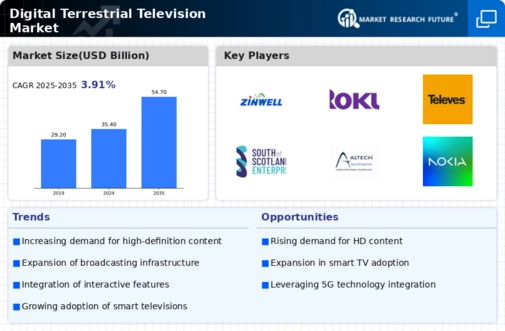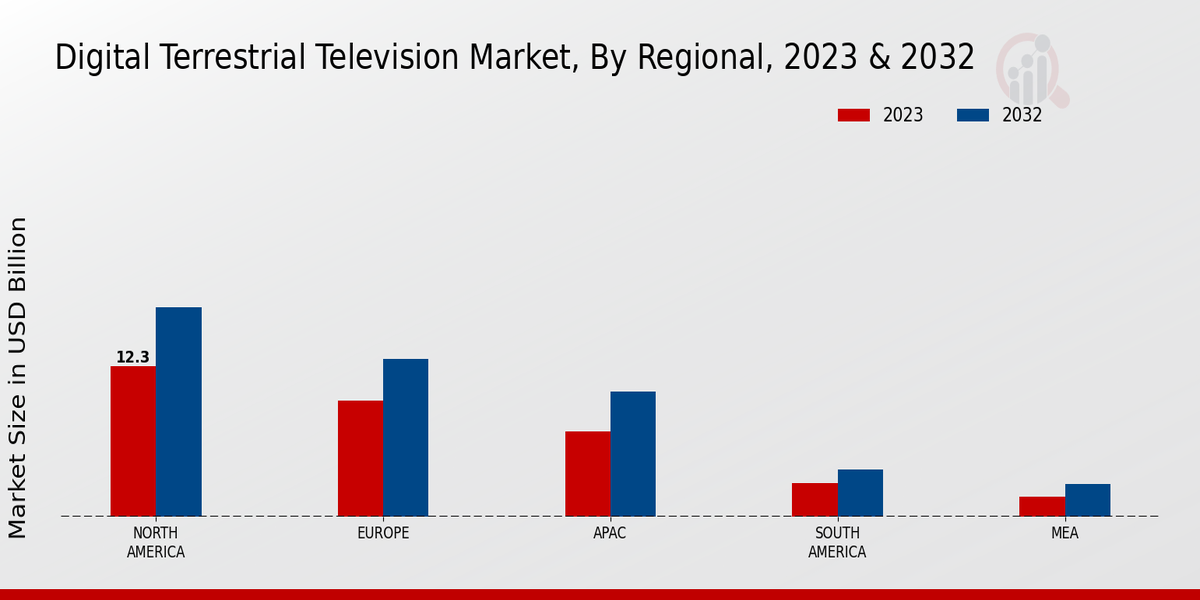Market Growth Projections
The Global Digital Terrestrial Television Market Industry is projected to experience substantial growth over the next decade. With a revenue forecast of 35.4 USD Billion in 2024 and an anticipated increase to 54.7 USD Billion by 2035, the market is on a promising trajectory. This growth is underpinned by a compound annual growth rate (CAGR) of 4.05% from 2025 to 2035. Such projections indicate a robust demand for digital broadcasting services, driven by technological advancements, regulatory support, and changing consumer preferences.
Rising Penetration of Smart TVs
The increasing penetration of smart TVs is a notable driver for the Global Digital Terrestrial Television Market Industry. As consumers invest in smart televisions, which often come equipped with integrated tuners for digital terrestrial signals, the demand for digital broadcasting services is likely to rise. This trend is particularly pronounced in emerging markets, where affordability and accessibility of smart TVs are improving. The market's growth trajectory is supported by the anticipated increase in revenue to 54.7 USD Billion by 2035, as more households transition to digital viewing experiences.
Government Initiatives and Regulations
Government initiatives and regulatory frameworks significantly influence the Global Digital Terrestrial Television Market Industry. Many countries are implementing policies to promote digital broadcasting, aiming to enhance signal quality and expand access to television services. For instance, regulatory bodies are encouraging the transition from analog to digital broadcasting, which not only improves service quality but also frees up spectrum for other uses. These initiatives are expected to drive market growth, as they facilitate the adoption of digital terrestrial television, thereby increasing the industry's overall revenue potential.
Growing Demand for High-Definition Content
The Global Digital Terrestrial Television Market Industry is experiencing a surge in demand for high-definition content. As consumers increasingly seek superior viewing experiences, broadcasters are compelled to upgrade their transmission technologies. This shift is evident in the rising adoption of HD and 4K broadcasting standards, which enhance picture quality and viewer satisfaction. The industry's revenue is projected to reach 35.4 USD Billion in 2024, reflecting this growing consumer preference. Furthermore, advancements in compression technologies enable broadcasters to deliver high-definition content efficiently, thereby expanding the market's reach and appeal.
Technological Advancements in Broadcasting
Technological innovations play a pivotal role in shaping the Global Digital Terrestrial Television Market Industry. The introduction of advanced broadcasting technologies, such as DVB-T2 and ATSC 3.0, enhances signal quality and transmission efficiency. These technologies facilitate the delivery of multiple channels and interactive services, thereby attracting a broader audience. As a result, the market is poised for growth, with a projected CAGR of 4.05% from 2025 to 2035. This growth is indicative of the industry's adaptability to evolving consumer preferences and technological landscapes, ensuring its relevance in the competitive media environment.
Consumer Preference for Cost-Effective Solutions
Consumer preference for cost-effective television solutions is reshaping the Global Digital Terrestrial Television Market Industry. Digital terrestrial television offers a viable alternative to cable and satellite services, often at a lower cost. This affordability appeals to budget-conscious consumers, particularly in regions where subscription services may be prohibitively expensive. As a result, the market is witnessing an influx of new subscribers, contributing to its overall growth. The industry's ability to provide quality content without the burden of high subscription fees positions it favorably in a competitive landscape.






















Leave a Comment